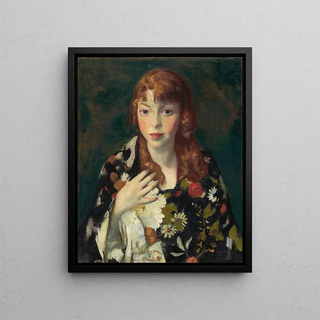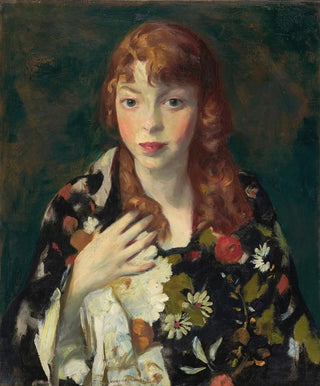Art print | Edna Smith in a Japanese wrap - Robert Henri Source: Reproduction | Edna Smith dans un wrap japonais - Robert Henri


View from behind

Frame (optional)
Edna Smith in a Japanese wrap art print by Robert Henri is a piece that transcends simple portraiture to become a true immersion into the intimacy and personality of its model. This painting, which captures a woman wrapped in a fabric with Japanese motifs, evokes not only beauty and grace but also a certain psychological depth. Henri, a prominent figure of the American realist movement, manages to combine pictorial technique with modern sensitivity, offering a fascinating vision of the world around him. Through this work, the viewer is invited to explore not only form but also emotion and character of the depicted woman, Edna Smith, whose expression and pose seem to tell a story far beyond the canvas.
Style and uniqueness of the work
Robert Henri's style is distinguished by his ability to capture light and shadow, while highlighting color and texture. In "Edna Smith in a Japanese wrap," each brushstroke appears to be charged with intention, with a delicacy that makes the work come alive. The way the Japanese wrap drapes the model's body is a perfect example of the artist's mastery in representing fabrics, a skill that allows him to give an impression of movement and fluidity. The chosen hues, both vivid and harmonious, create a warm atmosphere, while the blurred background helps focus attention on Edna and her garment. This stylistic choice emphasizes the beauty of the subject while evoking a certain melancholy, an introspection that invites contemplation.
The artist and his influence
Robert Henri, born in 1865, is one of the leading representatives of the Ashcan School movement, which advocated a realistic approach to urban life and contemporary subjects. His work was influenced by great European masters, but he developed a unique voice of his own. Henri had a passion for depicting ordinary people, scenes of daily life, and portraits that capture the very essence of his subjects. Through his works, he sought to give a voice to the voiceless, to celebrate the beauty of everyday life, and to question norms

Matte finish

View from behind

Frame (optional)
Edna Smith in a Japanese wrap art print by Robert Henri is a piece that transcends simple portraiture to become a true immersion into the intimacy and personality of its model. This painting, which captures a woman wrapped in a fabric with Japanese motifs, evokes not only beauty and grace but also a certain psychological depth. Henri, a prominent figure of the American realist movement, manages to combine pictorial technique with modern sensitivity, offering a fascinating vision of the world around him. Through this work, the viewer is invited to explore not only form but also emotion and character of the depicted woman, Edna Smith, whose expression and pose seem to tell a story far beyond the canvas.
Style and uniqueness of the work
Robert Henri's style is distinguished by his ability to capture light and shadow, while highlighting color and texture. In "Edna Smith in a Japanese wrap," each brushstroke appears to be charged with intention, with a delicacy that makes the work come alive. The way the Japanese wrap drapes the model's body is a perfect example of the artist's mastery in representing fabrics, a skill that allows him to give an impression of movement and fluidity. The chosen hues, both vivid and harmonious, create a warm atmosphere, while the blurred background helps focus attention on Edna and her garment. This stylistic choice emphasizes the beauty of the subject while evoking a certain melancholy, an introspection that invites contemplation.
The artist and his influence
Robert Henri, born in 1865, is one of the leading representatives of the Ashcan School movement, which advocated a realistic approach to urban life and contemporary subjects. His work was influenced by great European masters, but he developed a unique voice of his own. Henri had a passion for depicting ordinary people, scenes of daily life, and portraits that capture the very essence of his subjects. Through his works, he sought to give a voice to the voiceless, to celebrate the beauty of everyday life, and to question norms






